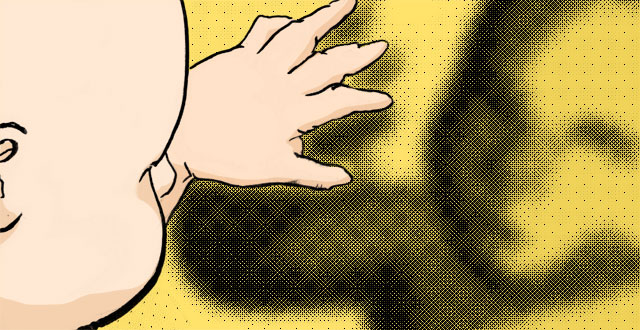When I start Kinect Adventures and am hit by a red ball in the face, I experience a vicarious twinge of pain. My self-made avatar, large and optimistic, is splayed out on the screen. He glares back at me. Even Dance Central never required me to glare at myself.
Kinect Fun Labs purports to demonstrate, to an even greater degree, Kinect’s potential to allow us to play as ourselves. This free suite comes, currently, with four applications: Kinect Me, Build a Buddy, Googly Eyes, and Bobble Head. They are demonstrations of the sorts of things Kinect can do: one-off experiments with a “gee-whiz” factor. The first thing Kinect Me asks me to do is stare intently at myself—positioning my face on the screen so that Kinect can adequately capture my face. It snaps a picture, then directs its attention to my body. I am wearing plaid shorts and an ironic videogame T-shirt.
A drum roll leads to fanfare as a red curtain pulls back to reveal an awful semblance of me—dressed in nearly identical clothes, except that my plaid shorts have been extended to full-fledged pants that could not possibly exist in the worlds of high or low fashion, for good reason. My shirt is accurately represented; the problem is, when I’m looking at it from this angle—as anyone else would see it—I can’t deny its dorkiness. It is overly clever, a painterly portrayal of the original Donkey Kong. The ultimate insult is my face, crudely grafted onto an oddly shaped head.
French psychoanalyst Jacques Lacan talked about the “mirror stage,” when infants first discover themselves in a mirror and begin to realize their limitations. They recognize aspects of themselves that are beyond their control, and strive to control those aspects. They use the mirror as both an indicator and a tool, to accurately move their arms, hands, fingers.
But the mirror is significantly more reliable than the Kinect, the Kinect Me application in particular. What results from this application is an arresting moment of second-guessing myself and my lifestyle choices. Why am I dressed like this? Why do I insist on wearing these T-shirts that thrust my obsessions onto the world? I immediately change into jeans and a more generic shirt, and feel slightly better. As my wife and I prepare to go out for dinner, I ask her, because I have to know: “Do I look stupid?”
/ / /
Build A Buddy asks that I find an object that means something to me. For Build a Buddy, I choose my wife’s teddy bear, which I made for her at a Build-a-Bear workshop on our trip to Chicago. It wears a Cubs shirt. I scan the object, and watch it bounce around the screen and pretend to be a ninja. It is warped and unnatural; and I can still see my hands grafted onto its waist.
Kinect puts Googly Eyes onto my iPad. I jump and swerve and watch my iPad do the same. I am playing as an iPad, having answered the question, “Which of your inanimate objects would you like to bring to life?” with “My iPad!” I am glad no one is watching.
/ / /
According to Lacan, our true selves are truly realized when we are interacting with others, giving us an opportunity to illuminate one another’s characteristics and personalities. This is the key component missing from Microsoft’s latest Kinect offering. Kinect Fun Labs offers a new technology, but fails utterly at helping us to understand why we would want it in the first place. What’s the point of creating a life-like version of myself, if all I can do is stare at it and scrutinize it? In games, I feel better when I am talking, cooperating, and competing with someone else. This collection of programs is indeed a fascinating look at the future of videogames, but it’s not a flattering one.
My Kinect Me avatar, with its reproduction of my face and clothes, stands solitary on a stage. The stage is much too big for him—it makes him look small and lonely. I change the background to what looks like a forest, or a jungle. I move, and I become this avatar. I move, I jump, I pose. After every pose, the camera clicks. I share the pictures with my Xbox Live friends, because Kinect Me asks me to, but I immediately regret it.
Even when I attempt clever or interesting poses, I feel a kind of falsehood that I feel in everyday life, surrounded by people, but without a reason to truly interact with them. Outside my apartment, I see no opportunity to commune with others in any meaningful way. In Kinect Me, we share our images with one another, but we are like strangers in passing—exchanging avatar images without context or elaboration. We try to create that context with T-shirts that demonstrate our interests—but more often than not they seem to backfire. The only option left is to look our best, and get home as quickly as possible. I wince at the portrait I have just sent to my friends, and turn off the Xbox 360, relieved to see the Kinect’s green light fade.
In the supermarket I see a man in the checkout line making pleasant, authentic conversation with the lady who is scanning his groceries. When it’s my turn, all I can think is that I wish she wouldn’t make conversation about the frozen pizzas, shampoo, and trail mix that I am buying. I am not cut out for this, and I just want to be alone.
Illustration by Daniel Purvis
